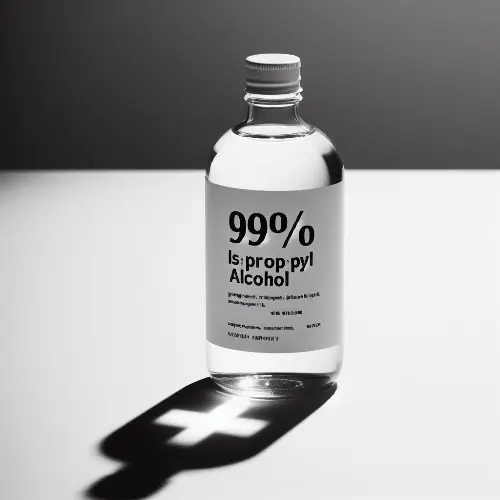Thekitchenkits.online is an Amazon Associate and earns from qualifying purchases made through affiliate links on our site at no extra cost to you. This supports our efforts to bring you valuable kitchen-related content.
Table of Contents
Can You Microwave Rubbing Alcohol
Rubbing alcohol, also known as isopropyl alcohol, is a common household item found in many medicine cabinets and first aid kits. It is an effective disinfectant and cleaning solution.
But is it safe to microwave rubbing alcohol? Let’s take a closer look at whether you can and should microwave rubbing alcohol.
What is Rubbing Alcohol?
Rubbing alcohol is a solution made from 70-99% isopropyl alcohol and water. Isopropyl alcohol is an antiseptic that helps kill bacteria on skin and surfaces. Rubbing alcohol also evaporates quickly, making it useful for disinfecting and cleaning.
Some major uses of rubbing alcohol include:
- Disinfecting cuts and scrapes to prevent infection
- Cleaning kitchen and bathroom surfaces
- Removing permanent marker stains
- Cleaning electronic devices like thermometers and probes
- Prepping skin before injections
Rubbing alcohol is a staple in most homes because it is inexpensive and versatile. However, it does have some risks. The main risks of rubbing alcohol are flammability and potential poisoning if ingested.
Is It Safe to Microwave Rubbing Alcohol?
The short answer is no – you should never microwave rubbing alcohol.
Here’s why:
- Rubbing alcohol is highly flammable. When heated in the microwave, rubbing alcohol can easily ignite and result in a fire or explosion. Even a small amount is dangerous. The flammable vapors can spark and catch fire rapidly in the enclosed microwave.
- It will evaporate extremely quickly. Rubbing alcohol has a low boiling point. When heated in the microwave, the rubbing alcohol will turn into vapor and evaporate almost instantly. This evaporation can be dangerous due to flammability and inhalation risks.
- Microwaving doesn’t effectively sanitize. The quick evaporation means the rubbing alcohol won’t have time to fully sanitize whatever it’s applied to. You need several minutes of contact time to properly disinfect.
- The fumes are toxic if inhaled. Heating rubbing alcohol releases concentrated fumes that should not be inhaled. Breathing in the vapors intentionally is extremely dangerous.
- The high heat can damage the microwave. The heat and possible ignition of vapors can damage the interior of the microwave. Burned food remnants or alcohol stains will make it unusable.
- It provides no real benefits. Simply leaving a rubbing alcohol-soaked item out to air dry provides the same sanitizing and evaporative effects without the explosion risk.
For all these reasons, never microwave a container of rubbing alcohol or a rubbing alcohol-soaked object. The risks drastically outweigh any small benefits.
What Happens If You Microwave Rubbing Alcohol?
Here is what happens if you make the very dangerous mistake of microwaving rubbing alcohol:
- Within seconds, the rubbing alcohol will turn into vapor and evaporate. A large portion will evaporate before you even have time to stop the microwave.
- The concentrated vapors have a high chance of catching fire and igniting. This fire will quickly spread and engulf the interior of the microwave.
- The buildup of flammable vapors can also cause an explosion that shatters the glass tray or door. This sends shrapnel flying dangerously.
- You will be exposed to toxic fumes that can cause breathing problems, nausea, and headaches if inhaled. Never lean over a heated container of alcohol.
- The interior of the microwave will be damaged from heat, flames, smoke, and combustion residue. It will need extensive repairs or full replacement.
If you microwave a small amount in just a few seconds, you may avoid fire or explosion. But the container will be extremely hot, fumes will still evaporate, and damage is still likely. Never microwave for more than 1-2 seconds just to be safe.
Is It Safe to Heat Rubbing Alcohol Other Ways?
Do not use the microwave, but gently warming rubbing alcohol can increase its disinfecting effects. Here are some safe ways to heat rubbing alcohol:
- Apply rubbing alcohol to a cloth or cotton swab, then hold it over a radiator or other indirect heat source. Never over direct flame.
- Place a bowl or bottle of rubbing alcohol in warm water until it reaches the desired temperature. Change the water as needed.
- Use an electric heating pad or heating lamp from a safe distance to warm rubbing alcohol-soaked onto a cloth. Monitor closely to prevent overheating.
- For cleaning tough messes, fill a spray bottle with warm water and add a few tablespoons of isopropyl alcohol. The heated mixture can help dissolve oils.
No matter the method, always monitor the temperature closely and keep it away from sparks, flames, or other ignition sources. Rubbing alcohol should never be allowed to reach a boiling point. Warming instead of overheating reduces its flammable vapors.
What are the Dangers of Ingesting Rubbing Alcohol?
One major danger of rubbing alcohol is poisoning caused by drinking or swallowing it. This can occur accidentally or intentionally when people drink it as an alcohol substitute. Consuming isopropyl alcohol can cause:
- Nausea, vomiting, and abdominal pain
- Drowsiness, confusion, headaches, and dizziness
- Breathing difficulties
- Low blood pressure
- Loss of coordination and balance
- Throat, stomach, and intestinal irritation
- Liver and kidney damage
- Unconsciousness, coma, or death
If rubbing alcohol is ingested, call the poison helpline right away. Do NOT induce vomiting unless told to by poison control. The victim should drink water or milk to dilute the substance, but not if they are having respiratory distress. Other first-aid steps can include activated charcoal pills to absorb the toxin.
Most cases of isopropyl alcohol poisoning occur in children or intentionally by teenagers or adults seeking an inexpensive, accessible alcohol source. Keep rubbing alcohol locked away and out of sight of children to prevent accidental ingestion.
FAQs
Can you microwave rubbing alcohol?
It is not advisable to heat or microwave rubbing alcohol. Rubbing alcohol, also known as isopropyl alcohol, is highly flammable and can produce harmful fumes when heated. It is not safe to heat up rubbing alcohol in a microwave as it can lead to a potential fire hazard.
Is it safe to heat up rubbing alcohol?
No, it is not safe to heat up rubbing alcohol. Rubbing alcohol is highly flammable and heating it can result in dangerous situations. It is important to keep rubbing alcohol away from heat sources and avoid using it near open flames or in a microwave.
Can rubbing alcohol be used in cooking?
Rubbing alcohol, including isopropyl alcohol, should not be used in cooking. It is not safe for consumption and can cause serious health issues if ingested. Isopropyl alcohol is commonly used as a solvent or for cleaning purposes, but it should never be used as an ingredient in food or drink.
What happens if you microwave rubbing alcohol?
Microwaving rubbing alcohol can be extremely dangerous. Rubbing alcohol is highly flammable and heating it in a microwave can cause it to release flammable vapors which may ignite and cause an explosion. It is crucial to never attempt to microwave rubbing alcohol.
Can rubbing alcohol evaporate in a microwave?
Yes, rubbing alcohol can evaporate in a microwave if heated for an extended period. However, as mentioned earlier, this is not a safe practice due to the flammable nature of rubbing alcohol. It is highly recommended to avoid heating rubbing alcohol in a microwave.
Can I use rubbing alcohol to clean and disinfect surfaces?
Yes, rubbing alcohol can be used to clean and disinfect surfaces. Isopropyl alcohol, with a concentration of at least 70%, is commonly used as a disinfectant to kill bacteria and viruses. However, it should be used as directed and in well-ventilated areas to avoid inhalation of fumes.
How long should I heat rubbing alcohol in a microwave?
Rubbing alcohol should never be heated in a microwave. It is highly flammable and can cause fires or explosions if exposed to heat sources. It is important to always follow the recommended usage instructions provided by the manufacturer when using rubbing alcohol.
What are the major uses of rubbing alcohol?
Rubbing alcohol, or isopropyl alcohol, has several major uses. It is commonly used as a disinfectant to clean and sterilize surfaces. It is also used as a solvent in various industries, including pharmaceuticals, cosmetics, and electronics. Moreover, rubbing alcohol can be used to remove stains and dissolve certain substances.
Is rubbing alcohol safe to use as a cosmetic?
Rubbing alcohol should not be used as a cosmetic unless specifically stated by the product manufacturer. Isopropyl alcohol can be harsh on the skin and may cause irritation, dryness, or other adverse effects. If you are considering using rubbing alcohol for cosmetic purposes, it is advisable to consult a healthcare professional or dermatologist.
How long can you microwave rubbing alcohol for cleaning purposes?
Rubbing alcohol should never be microwaved for cleaning purposes. Heat can cause flammable vapors to build up inside the microwave, creating a potential fire or explosion hazard. It is best to use rubbing alcohol for cleaning surfaces without heating it in a microwave.
Conclusion
Rubbing alcohol or isopropyl alcohol can be a versatile household cleaner and disinfectant, but like any chemical, it carries risks if handled improperly. Never microwave rubbing alcohol under any circumstances due to its extreme flammability and potential to ignite, explode, or release toxic fumes.
Use safer heating methods instead, while taking care to closely monitor temperature and keep the rubbing alcohol away from open flames. Always store rubbing alcohol securely and prevent accidental ingestion to avoid poisoning dangers. With responsible use, you can safely take advantage of rubbing alcohol’s sanitizing abilities without endangering yourself or your microwave.

I’m Ian Welkins, a seasoned professional in the kitchen industry. My passion now drives me to provide invaluable insights into the world of top-notch kitchen products. With years of hands-on experience, I’m your go-to source for culinary excellence.


